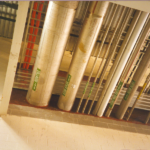
Common firestop code violations
The best way to keep smoke and toxic gases from spreading throughout a building is through containment, essentially dividing a building into “boxes” to protect occupants as they exit the building. One element of containment is firestopping.
What is firestopping? Perhaps the easiest way to explain it is to describe what it is not. It is not draftstopping, which restricts the movement of air in concealed locations of combustible construction. It is not fireblocking, which is used in concealed locations in combustible construction to resist the passage of flame to other areas. Nor is it foam insulation, which has been used in combustible construction in conjunction with fireblocking.
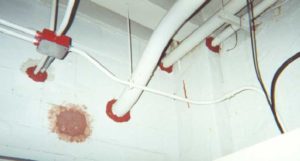
According to ASTM E814, “Fire Tests of Penetration Firestop Systems,”¹ a firestop system is defined as “a specific combination of penetration item or items, the specific construction that is penetrated, and the materials or devices, or both, that seal the opening provided to accommodate one or more items that penetrate into or through a fire-resistance rated assembly”. Based on that definition, firestopping itself is a component of a system, most often associated with a through-penetration firestop system. Firestopping itself cannot be tested as it must be part of a system. As outlined in the definition, a through-penetration firestop system comprises three elements: a fire-rated assembly, be it a wall or a floor; a penetrating item, such as a sprinkler pipe; and the firestop material(s). These systems are tested to determine the performance of a firestop system with respect to exposure to a standard time-temperature fire test and a hose-stream test. The performance of the system is dependent upon the specific assembly of materials tested including the number, type and size of penetrations and the materials of the floors or walls in which it is installed.
The importance of firestopping in life safety has been well documented but, unfortunately, not well understood One of the main misconceptions is that if most of the areas targeted for firestopping are treated, that will suffice. Unfortunately, unless you install firestop systems exactly as their listing details, there can be no guarantee that they will perform as intended. How can you correct this problem? The first step is to address problems that occur in the field.
The following is a list of situations which may present themselves in the field not only to the general contractor, but also to the authority having jurisdiction or other agency performing inspections on firestop systems.

No plan review or lack of information on plans for firestopping
The first opportunity to address potential firestopping issues is at the plan-review stage. The plans examiner can review the plans for various penetrating items and require that the plans include listing details for those penetrating items. The International Building Code (IBC) in Section 107.2.1 requires that plans must show in detail that the proposed installation will meet code. For firestopping, the only detail that would definitively show compliance would be to provide the specific tested/listed system for each specific application. If the plan does not provide this information, it is often left to the inspector to address in the field, when the work has already been completed and the system is more difficult to inspect as well as more difficult to access from a design perspective to determine the appropriate listing detail. Firestop submittals will often be deferred submittals (as addressed by IBC 107.3.4.1) since the precise firestop system to be used may not be known until other site specific details are established.
Wall ratings (fire, air/smoke)
Both penetration and perimeter containment systems are required to meet mandatory flame passage restrictions. These are noted with an “F” for flame occurrence. In addition, penetrations and joints in vertical or horizontal assemblies that serve as smoke barriers must also restrict the movement of smoke. Penetration firestops, fire resistive joint systems and perimeter containment systems, within or at the perimeter of smoke barriers, will also require to have an “L” or air leakage rating.
Top and bottom of walls firestopped
In addition to through-penetration firestop systems, both the top and bottom of the wall must be firestopped. This can be achieved through the use of “head-of-wall” and “bottom-of-wall” joints.
Incorrect fasteners
Did you know that some firestop materials intumesce (expand) when exposed to heat? Intumescent firestop materials are most often used with penetrating items that can melt, burn or change their shape in a fire, such as plastic pipe or glass fiber pipe insulation. Intumescent materials can expand up to 25 times their initial volume. If the correct fastener schedule is not followed, the intumescent material is not held in place, nor is it able to expand in the correct direction, allowing fire, smoke and gases to breach the barrier.
Orientation of forming material
 Forming materials are proprietary materials that are independently tested and listed by the listing laboratories. Many tested and listed joint systems, and especially perimeter fire containment systems, will state the specific orientation of the forming material (boards or sheets), such as mineral wool. Mineral wool is a layered product and a key component of perimeter fire containment systems as well as joint firestop systems. Simply stuffing in a wad of mineral wool or placing it in an incorrect orientation will cause system failure as the proper compression may not be achieved.
Forming materials are proprietary materials that are independently tested and listed by the listing laboratories. Many tested and listed joint systems, and especially perimeter fire containment systems, will state the specific orientation of the forming material (boards or sheets), such as mineral wool. Mineral wool is a layered product and a key component of perimeter fire containment systems as well as joint firestop systems. Simply stuffing in a wad of mineral wool or placing it in an incorrect orientation will cause system failure as the proper compression may not be achieved.
Correct type of packing material
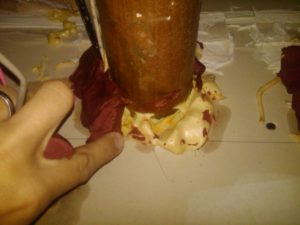
Many firestop systems will specify the acceptable types of packing material, which are generic materials used to fill a gap. The packing material will commonly provide the support for the firestop material.
Keep in mind that products with a high flame spread would definitely not be an approved packing material. Any packing material that would melt, or burn at all, even with a low flame spread, would not work for firestopping systems. Glass fiber is not suitable, even though it is not combustible and does not melt. Note, however, that a small number of listed systems do incorporate the use of non-fire resistant packing material, such as backer rods or glass fiber insulation, in applications where their lack of fire performance will not negatively affect the performance of the system. The key to proper system installation is to use only the packing materials specified in a given system, and in the specified manner. A common requirement for mineral wool used in penetration firestop systems is for it to be “tightly packed”.
Materials not included in listing
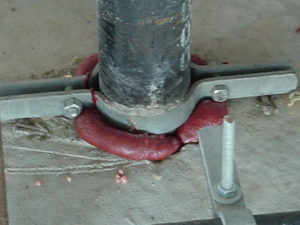
The tested and listed system specifically states the manufacturer and the exact products that may be used. There is NO substitution, as each product has different properties and these specific combinations and applications are what have passed testing. Many times, a system is incorrectly installed using a different manufacturer, the wrong firestop product or a different brand of insulation than what is specified in the listed system. For instance, combining an STI system with 3M firestop materials would not be acceptable.
Not enough materials
Firestop materials are some of the most expensive materials per ounce on the job site and typically cost many times more than labor. The tested systems created by the manufacturers represent the minimum amount needed.
Tooling
The problems listed above can lead to the following common firestop code violations, which if addressed correctly, can be prevented:
Piping
Metallic and nonmetallic in same penetration
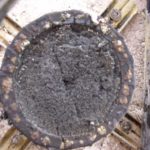 Nonmetallic piping will melt when exposed to fire, thus requiring a firestopping material which will expand (intumesce).
Nonmetallic piping will melt when exposed to fire, thus requiring a firestopping material which will expand (intumesce).
Metallic piping need only for the firestopping material to stay in place and remain adhered to both the penetrant and the substrate. To have both materials in the same penetration would require the firestop material to both remain in place as well as provide sufficient expansion to seal the created gap. There are systems that will provide for this; be sure to check the listed system to verify this can be accomplished.
Insulated versus non-insulated
If using an insulated penetrant, keep in mind that other than mineral or ceramic wool insulation, insulation will melt, burn or otherwise degrade, thus opening a gap that could allow for the passage of flames and hot gases. The firestopping system needs to provide enough intumescent to seal the gap left behind after the insulation has been damaged.
Insulation types (glass, mineral, foam)
There are a variety of insulation materials allowed as the packing material component of the firestop system. Those materials include ceramic (alumina silica) fiber blanket, foam backer rod, foamed silicone, glass fiber and mineral wool. Mineral wool has varying weights (densities) so be sure to check with the specific listing to verify the weight needed for that listing.
Collar versus no collar
Some systems require a collar for nonmetallic piping, while others do not. Check the system.
Electrical
Outlet boxes
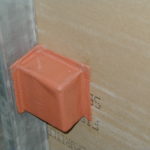 Membrane penetrations are treated similar to through penetrations. Generally, electrical outlets can meet firestopping requirements through the use of a putty pad and can be separated by a distance of less than 24 inches, provided the outlets are not back-to-back. There are some putty pads that do allow for back-to-back outlets so be sure to check the listing of the putty pad. The size of the outlet allowed to be protected with the use of a putty pads varies depending on the material of the box (metallic or nonmetallic), the depth of the box, and the rating of the wall/ceiling assembly. Code exceptions for firestopping of membrane penetrations exist for steel boxes that are less than 16 square inches and contribute to less than 100 square inches of openings within any 100 square feet of wall/ceiling area. Outlets on opposite sides of the wall must be separated a horizontal distance of at least 24 inches. The annular space between the wall/ceiling membrane and the box cannot exceed 1/8 inch.
Membrane penetrations are treated similar to through penetrations. Generally, electrical outlets can meet firestopping requirements through the use of a putty pad and can be separated by a distance of less than 24 inches, provided the outlets are not back-to-back. There are some putty pads that do allow for back-to-back outlets so be sure to check the listing of the putty pad. The size of the outlet allowed to be protected with the use of a putty pads varies depending on the material of the box (metallic or nonmetallic), the depth of the box, and the rating of the wall/ceiling assembly. Code exceptions for firestopping of membrane penetrations exist for steel boxes that are less than 16 square inches and contribute to less than 100 square inches of openings within any 100 square feet of wall/ceiling area. Outlets on opposite sides of the wall must be separated a horizontal distance of at least 24 inches. The annular space between the wall/ceiling membrane and the box cannot exceed 1/8 inch.
Conduit through head-of-wall joint
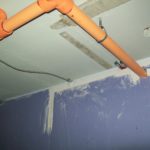 There currently exists a very limited number of tested and listed systems that allow penetrants to be installed through a head-of-wall joint.
There currently exists a very limited number of tested and listed systems that allow penetrants to be installed through a head-of-wall joint.
Here are several items which have penetrated the head of wall joint with no protection of the opening that has been created.
Cables
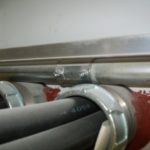 The tested and listed system will state the exact maximum fill percentage. Systems range from as little as 11-percent maximum fill up to 100-percent fill. Check the system to verify that the amount of fill is permitted. The paper contained in the opening is not permitted.
The tested and listed system will state the exact maximum fill percentage. Systems range from as little as 11-percent maximum fill up to 100-percent fill. Check the system to verify that the amount of fill is permitted. The paper contained in the opening is not permitted.
Cables should be evenly distributed within the trays (if so specified in the listed system) and should be treated similar to cable bundles for maximum percent fill. Installing a five-inch-deep cable tray when the prescribed firestop system is designed to work with a cable depth of three inches will cause the firestop system to fail.
Other items
Perimeter fire containment (slab edge joint)
These joints occur where the rated floor slab edge meets the non-rated exterior curtain wall and must be protected against the passage of flame, smoke and gases through the associated void. Because heat rises, positive pressure occurs at the ceiling line, rendering this area susceptible and providing an area for smoke and gases to pass through if not suitably firestopped with a tested perimeter fire containment system.
Product color
Not all firestop materials used in listed systems are red. Some are white, gray, yellow, green or other colors. Be sure to check the listing for the approved and tested material.
Cast-in-place devices
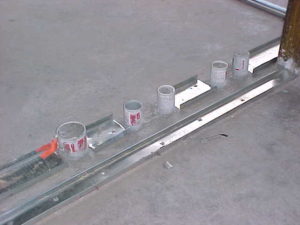 Cast-in-place devices are designed and tested for very specific type and size of penetrants. A three-inch PVC pipe through a four- or six-inch cast-in-place device is not an approved, tested and listed system.
Cast-in-place devices are designed and tested for very specific type and size of penetrants. A three-inch PVC pipe through a four- or six-inch cast-in-place device is not an approved, tested and listed system.
Atypical environments
In an atypical environment, i.e., one with high moisture or where chemicals are in use, typical firestop products might not be suitable. Have the contractor produce the firestop product data sheet and check for resistance to the gases, vapors, liquids or solids that are expected to exist in the immediate environment and which will contact the firestopping. If unsure, contact the manufacturer.
Incompatible products
Just as galvanic action occurs when copper and steel come into contact with each other, similar chemical reactions can occur between firestopping materials and the penetrating item they are intended to protect. Ensure the listing for the approved and tested materials is followed. Chemical compatibility is a particularly important issue when firestopping penetrations by CPVC piping. Verify compatibility of CPVC piping with the proposed firestop products using online lists provided by the CPVC pipe manufacturer, as pipe and firestop formulations change frequently.
Engineering judgments
Engineering judgments come into play when a condition exists in the field which differs from the available system listings or some other item creates a hindrance that cannot be easily corrected through redesign or reconstruction. Because the situation in the field is not based on the identical design which was tested, the engineered judgment must be based on internal test data and existing firestop systems. Engineering judgments should be specific to a single job and should not be transferred to any other job without a thorough review of all aspects of the new job. Generally, engineering judgments are issued by the manufacturer, a knowledgeable registered fire professional engineer or an independent testing agency.
Clearly, there is quite a lengthy list of items which can result in problems with the installation of firestopping materials. While this is not an all-inclusive list, any one of these items can contribute to a two-hour wall being reduced to a four-minute wall. For an inspector, one of the easiest ways to avoid problems in the field is to ask the installer for the tested and listed system utilized. A plans examiner should ask for the jurisdiction-approved plans to include details for all the proposed systems that could be encountered on the project based on the materials being used and the assemblies being penetrated. As a code official, it is imperative to have a comprehensive understanding of firestopping and the importance of properly enforcing it to ensure life safety, not only for those occupants of the building, but also for the fire service personnel who may be responding to the call.
Due to the complexity of firestop specification and installation, and therefore the complexity of firestop inspection, the IBC has mandated since the 2012 edition that firestopping be inspected via special inspection in the most critical applications, as defined in Chapter 17 of the IBC. High-rise and Risk Category III and IV buildings are subject to firestop special inspection. The code official’s role in those situations is to ensure that the code-mandated special inspection is being made, to approve the proposed special inspectors, ensuring that they have suitable qualifications, and finally to review the special inspection reports.
¹ ASTM E814, Standard Test Method for Fire Tests of Penetration Firestop Systems. ASTM International, West Conshohocken, Pa., 2006
Acknowledgements: Some photos have been provided courtesy of the International Firestop Council.

